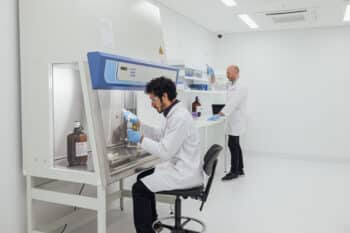A workplace that lacks worthwhile communication runs the risk of grinding your lab’s gears to a halt, and with a lot of different personalities, the environment can get bumpy at times. Good communication is an essential component in the workings of any team. With it, the gears run a lot smoother, ensuring quality work and a strengthening of relationships, which members of the team will value day after day.
Along with insights from those in the know, we’ll guide you through a variety of methods you can use in the lab to strengthen your communications amongst your team.
Quick Navigation
- Take note of how your colleagues like to communicate
- Seek advice from colleagues
- Managers – learn the art of MBWA
- Practice your listening skills
- Ask the right questions, properly
Take note of how your colleagues like to communicate
With so many personality types in the lab, it can be easy to forget how people like to work. Some appreciate being approached throughout the day, others prefer working on their own, undisturbed. It’s important to be mindful of how your colleagues communicate with others.
As the American Journal Experts ask: “Do your colleagues like to communicate in person or do they prefer email and digital conversations? Chances are some of your labmates prefer one and some prefer another.”
Likewise, take note of the amount of communication you approach them with: “Some people thrive on continuously connecting, while some find constant interactions to be draining. Learning the different styles of each of your colleagues can be very helpful in balancing and maintaining good relationships.”
Seek advice from colleagues
Never underestimate the value of looking to your colleagues for advice as a means of opening up and strengthening communication channels.
The Journal of Cell Science presents the following scenario: “The audience at a lab meeting has no doubt heard about the success of your latest experiment or the demise of yet another attempt to perform a simple ligation. But this is the time to show their ability to be constructively critical – sympathetic in their assessment of the problem – and collegial.”
“It is important to be able to [publicly] acknowledge someone else for performing a great experiment, and in the case of a problem it is likely that you will either have come across the same one or will do so in the future”.
Managers – Learn the art of MBWA
A good rapport with your team is essential. Shed the notions that you’re above those working for you; the old spiel of “I’m not here to make friends” doesn’t cut it anymore and won’t help anyone.
John K. Borchardt, of LabManager.com, is a firm believer in the employer/employee relationship. He says “Make yourself available to your employees. Practice ‘managing by walking around’ (MBWA). MBWA isn’t just a stroll through labs and offices; it’s a determined effort to understand what your staff does and to learn how you can help them do it better. Casual discussions can be very illuminating and motivating. MBWA can also be a very effective way to prevent workplace rumours or limit their harmful effects.”
MBWA fosters rapport over report, encouraging invaluable two-way communication. “When your staff sees you as a person and not just a boss, they’ll be more likely to tell you what’s going on”, says John. “You’ll get the chance to learn about issues before they become problems. You’ll gain a better understanding of your staff members’ work processes. As your staff gets to know you better, they’ll trust you more and be more likely to share information on a timely basis.
“When practising MBWA, be sure you apply the technique to all staff members. Don’t ignore some staff members to spend more time with your favourites”. Also, once you establish the habit, maintain it. MBWA is not something you can turn on and off. You need to practice it consistently for it to be an effective technique.”
Practice your listening skills
Following on from the previous point, sharpening up your ear when it comes to your team/colleagues’ problems ingratiates yourself with others, and lets colleagues know you’re open to discussing any problems they might have with you.
John offers a few pointers on how to improve your listening skills: “Adopt a posture that indicates active listening and maintain eye contact. Ask open-ended questions to verify that they understand the message you are trying to send. Nod or make affirmative gestures or comments to indicate that you understand what they are saying.”
Don’t forget about your body language either, as John notes: “Control unintentional message senders such as letting your eyes wander, folding your arms, or leaning away from someone. These imply disagreement, disinterest, or lack of respect. Remember, body language can speak volumes about your attitude.”
Ask the right questions, properly
“Don’t be afraid to ask questions”. Everyone’s heard this old workplace chestnut before, and while there’s value in querying things, be mindful of the quality of your questions.
Susan M. Heathfield, of The Balance, notes: “Bad questions often prompt incomplete or misleading answers and can undermine rapport. On the other hand, good questions are a valuable tool of efficiency, competence, and rapport-building.”
To this end, she quotes James O. Pyle and Maryann Karinch, who has written on what they believe are the six types of good questions: direct, control, repeat, persistent, summary, and non-pertinent:
- Direct: You pose a simple question with a basic interrogative.
- Control: You already know the answer to it when you ask it. It’s a way of finding out whether or not the person is lying, uninformed, and/or not paying attention.
- Repeat: You ask two different questions that are after the same information.
- Persistent: You ask the same question in different ways to explore all facets of the desired information.
- Summary: You ask a question that is intended to allow the source an opportunity to revisit the answer.
- Non-pertinent: It doesn’t pertain to the subject you want to know about, but it’s one the person will probably not lie about. It serves the purpose of seeing what the truth ‘looks like’ and getting the person to open up to you. It can also tie into the context of the questioning exchange.
Susan says that valid questions help to inspire confidence no matter the workplace. Thoughtful, considered questioning has a positive effect on both personal and professional communication, so it’s well worth placing value on it. Compare it with our first tip and how people like to be approached, perhaps you can tailor the question to the person?
Enjoyed this article? There’s plenty more to be found over on the InterFocus blog. Looking for information on our bespoke fitted labs? Visit our homepage or call the team on 01223 894 833.







